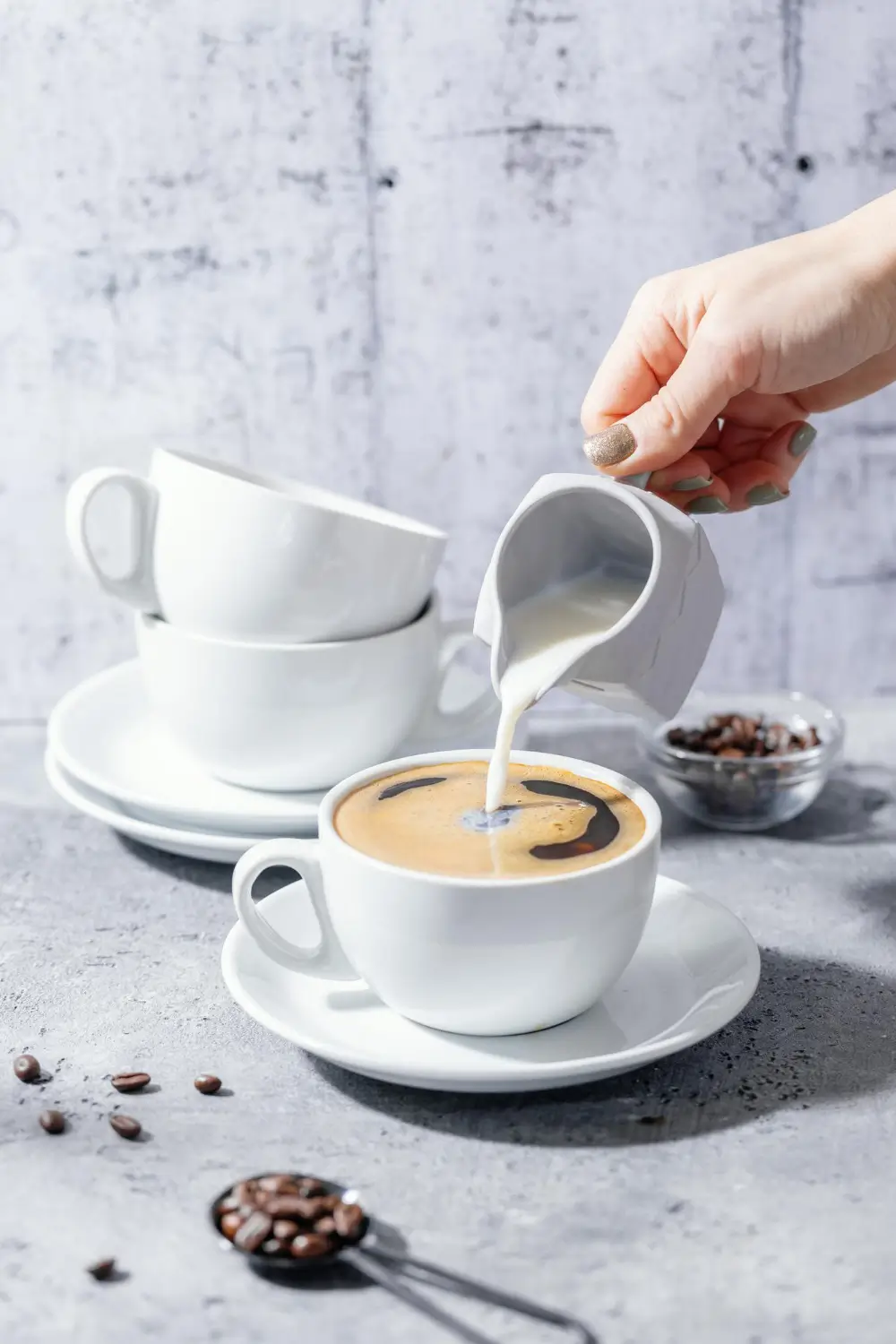Have you ever heard the term “white coffee” and found yourself wondering what it really means? It’s kind of a trick question, honestly, because its meaning can totally change depending on where you are in the world. For some, it’s just your everyday coffee with a bit of milk or cream. But for others, it describes a very specific, lightly roasted bean with its own distinct flavor and brewing method. Let’s break down these different ideas and explore the surprising world of white coffee.
What exactly is “white coffee”? A global perspective
The term “white coffee” can be surprisingly vague. Its meaning really shifts from place to place, so let’s get a clearer picture of what people mean by it around the world.
White coffee as coffee with milk/cream
When you hear “white coffee,” you might imagine a regular cup of coffee, just lighter in color. In many English-speaking countries, especially the UK, that’s exactly what it means: it’s simply black coffee with milk, cream, or a non-dairy whitener mixed in. It’s how people differentiate it from “black coffee,” which, of course, comes without dairy. Here in the United States, we typically just call this “coffee light” or “coffee with milk,” and we often use non-dairy creamers and sweeteners to lighten it up.
White coffee as a unique light roast
Now, this is where “white coffee” gets a totally different meaning for some people. This version refers to a coffee bean that’s been roasted incredibly lightly—so lightly, in fact, that the process stops before the beans hit what’s known as the “first crack.” Because of this, the beans end up pale yellow or beige, not the deep brown you’re probably used to. The flavor is quite distinctive: often sweet, nutty, and occasionally even reminiscent of a light tea. Interestingly, this particular light roast actually has historical roots in Yemen.
Regional variations: More than just two meanings
The term “white coffee” really becomes fascinating when you consider how different cultures interpret it. It’s not just about a super light roast or simply adding milk; there are some truly unique regional versions worth exploring.
- Ipoh white coffee from Malaysia, for example. This isn’t about the roast level of the bean itself, but rather the way the drink is prepared. The beans are actually roasted with margarine, and the final beverage is typically served with condensed milk, creating a rich, creamy, and sweet experience. You’ll find a similar style in Indonesia, often called Kopi Putih.
- Then there’s Lebanese white coffee, which might surprise you the most. Despite the name, it contains absolutely no coffee! Instead, it’s a caffeine-free, warm beverage made from water infused with fragrant rose or orange blossom water and sweetened. It really highlights just how versatile—and sometimes misleading—the term “white coffee” can be.
| Type of “White Coffee” | Key Characteristic | Common Region/Origin | Notes |
|---|---|---|---|
| Coffee with milk/cream | Standard black coffee with dairy or non-dairy whitener added. | English-speaking countries (e.g., UK, US) | Simple distinction from “black coffee.” Often called “coffee light” in the US. |
| Unique Light Roast | Beans roasted very lightly, before “first crack,” resulting in pale yellow/beige beans. | Historically Yemen | Distinct nutty, sweet, sometimes tea-like flavor. Higher caffeine content. |
| Ipoh White Coffee | Beans roasted with margarine; beverage served with condensed milk. | Malaysia (also Kopi Putih in Indonesia) | Results in a rich, creamy, and sweet drink. |
| Lebanese White Coffee | No coffee; a warm, caffeine-free beverage made from water infused with rose or orange blossom water. | Lebanon | Sweetened and fragrant. Highlights the term’s versatility. |
The unique roasting process
Let’s dig a little deeper into the specific process behind creating that unique light-roasted white coffee. It’s a roasting method that’s quite distinct from what you normally see.
Low temperature, short duration
At its core, white coffee roasting is all about low heat and a quick process. Green coffee beans are roasted at a much lower temperature—around 300–325°F (about 162°C)—compared to traditional roasts, which often hit well over 350°F. The roast itself is also pretty short, usually just 5 to 7 minutes. The beans are pulled from the heat right before they reach the “first crack,” that initial popping sound beans make as they start to undergo major chemical changes. By keeping the temperature low and stopping before this point, we avoid both the Maillard reaction and caramelization, which are the processes that give regular coffee its deep brown color and complex flavors.
Stages of the white roast
The white roast process usually involves four distinct stages at this controlled low temperature:
- Drying stage: For the first 2–3 minutes at about 162°C (325°F), the beans simply dry out and start to turn a pale yellow.
- Browning stage: During the next 2–3 minutes at that same temperature, you’ll notice only very limited browning, meaning there’s minimal flavor development happening yet.
- Development stage: This final 1–2 minutes, still at 162°C (325°F), is so important. The beans won’t hit the “first crack,” so they stay hard, dense, and keep their high acidity and caffeine content.
- Cooling stage: Finally, the beans are cooled for 4–5 minutes at ambient temperature. This quick cooling stops the roasting process, preserving their pale color and delicate, unique flavors.
The unique characteristics of white coffee roast
So, what can you actually expect from that unique, light-roasted white coffee once you brew it? It really has a distinctly different sensory profile.
Appearance: A lighter hue
Visually, the beans themselves are much lighter—pale or golden—because they’ve been roasted so minimally. Once brewed, your coffee won’t be dark brown; instead, you’ll see a lighter, almost pale amber or light gold liquid in your cup.
Flavor profile: Nutty, floral, and mild
White coffee’s flavor is pretty unique. You’ll primarily notice a distinct nuttiness, often with notes of almonds, cashews, hazelnuts, or even peanuts. This comes from the lower roasting temperature, which really preserves those delicate flavors. You might also pick up subtle floral undertones—think jasmine, honeysuckle, or lavender—adding a lovely aromatic complexity. Sometimes, you’ll find fresh, almost vegetal notes, like green tea or a hay-like earthiness. Depending on the bean, you could even get hints of citrus, berries, or tropical fruit. The best part is that because the Maillard reaction and caramelization are limited, white coffee is generally far less bitter and acidic than your typical medium or dark roasts. It also tends to have a thin body, offering a smooth yet dry and lingering mouthfeel, kind of like a light tea.
Caffeine content: Is white coffee stronger?
This is a pretty common question, and the answer might actually surprise you: yes, white coffee generally contains more caffeine than traditionally roasted black coffee. Here’s why: the lower temperature and shorter roasting time actually preserve more of the natural caffeine in the beans. When coffee is roasted longer and darker, some of that caffeine gets lost through heat decomposition. Some reports even suggest white coffee can retain up to 50% more caffeine than fully roasted coffee. However, other studies have shown more modest increases—for instance, one scientific study found only about 3.4% more caffeine per 8-ounce serving in light roasts compared to dark ones. A couple of other things can also affect the caffeine levels:
- Bean type: If white coffee uses Robusta beans, which naturally have more caffeine than Arabica beans, you’ll definitely get an extra kick.
- Brewing method and serving size: How you brew your coffee and how much you drink will always influence your total caffeine intake.
So, while white coffee does tend to pack a bit more caffeine punch due to its unique roasting, the exact difference can vary.
How to prepare white coffee at home
Is white coffee for you?
After learning all about light-roasted white coffee, you might be wondering if it’s the right fit for your palate. If you typically find traditional coffee a bit too bitter or acidic, or if you’re looking for a different kind of coffee experience with a potential extra caffeine kick, then white coffee could be a great discovery for you. It offers a milder, nuttier flavor profile that really stands apart from standard roasts. It’s definitely worth exploring if you’re open to something new!
Conclusion
So, as you can see, the term “white coffee” is far more complex than you might initially think! Whether it means your morning cup with milk, a truly distinctive light-roasted bean, or even a delightful caffeine-free floral drink like the Lebanese variety, its definition really shifts depending on where you are and who you’re talking to. The light roast, in particular, stands out for its unique nutty flavor and its surprisingly high caffeine content. It’s a great example of just how diverse coffee can be.









